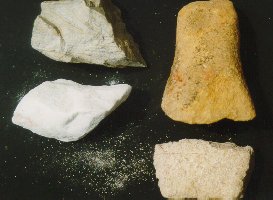Sandstone
Sandstone is composed of mineral grains (commonly quartz) cemented together by silica, iron oxide, or calcium carbonate. Sandstones are typically white, gray, brown, or red. Red and brown sandstones are colored by iron oxide impurities. Most sandstones feel gritty, and some are easily crushed (friable) and break up to form sand. Sandstones have pore spaces between each grain of sand; this property, called porosity, makes them good reservoirs for oil and natural gas.
Sandstones are very resistant to erosion and form bluffs, cliffs, ridges, rapids, arches, and waterfalls. Sandstones and conglomerates are responsible for most of the rugged topography in eastern Kentucky. Loose or unconsolidated sands cover much of the Jackson Purchase Region of western Kentucky. These sands are varicolored, but commonly white to light brown. Silica (quartz-rich) sands and sandstones of high purity (white color) are used extensively in the glass industry for manufacturing window glass, light bulbs, and containers. At present, glass sands are obtained from unconsolidated deposits near New Concord, Calloway County. Tightly cemented sandstone is used as a building stone.
Rock asphalt is a medium- to coarse-grained sandstone with asphalt (bitumen) filling the pore spaces. It is brown to black, has a pitchy to resinous luster, and when thoroughly saturated is very sticky.
Rock asphalt deposits were formed when erosion of the surface rocks exposed oil-bearing rocks and allowed the more volatile hydrocarbons to escape. The asphaltic-base crude gradually thickened until only a heavy tar or asphalt remained. The bitumen content of commercial rock asphalt varies from 3 to 15 percent.
Rock asphalt was once mined on a large scale in Kentucky. Large deposits occur in Edmonson, Grayson, and Hardin Counties in western Kentucky, and Carter County in eastern Kentucky. Periodically and most recently during the early 1980s, attempts have been made to reclaim the petroleum in the rock asphalt by heat treatment, distillation, and other processes.
Rock asphalt is used principally for surfacing streets and highways. Other uses are roofing, waterproofing, flooring for factories, and blending with rubber.

Go Back to Sedimentary Rocks
